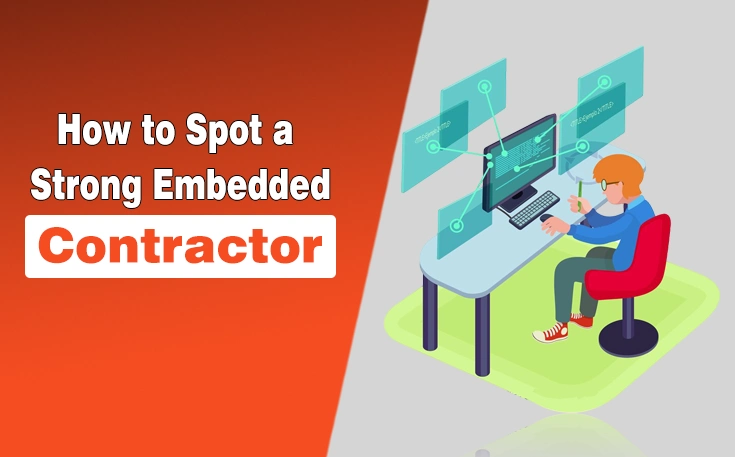In embedded development, mistakes are not just embarrassing — they can be disastrous. A single flaw in firmware can bring production lines to a halt, cause massive product recalls, or worse, endanger users. As a CTO, choosing the right embedded contractor is not just about cost or timelines — it is about protecting your product, your company, and your reputation.
Here is a clear, practical checklist to help you spot a strong embedded contractor — one that will be a true engineering partner, not just a code vendor.
What is an Embedded Contractor?
“An embedded contractor is a specialized software developer or team hired to build and manage firmware — the code that directly controls hardware devices.”
Unlike general app developers who follow basic app development tactics, embedded contractors work closely with circuit boards, microcontrollers, and sensors to ensure that the software integrates perfectly with the physical product.
Their work is critical because even a small coding mistake can crash devices, waste power, or cause product recalls. A good embedded contractor does not just write code — they understand the hardware, industry needs, and long-term product goals.
Thus, it makes them an essential partner for any company building connected, reliable, and efficient technology.
How to Spot a Strong Embedded Contractor?
In the under section, I have mentioned some points that will help you in finding a strong embedded contractor.
1. Subject Expertise – Context Matters, Not Just Code
Good embedded contractors do more than just “make the code run.” They understand the real world environment where your device operates — the regulations, user behaviors, and business requirements behind the product.
For example, if you are building a smart speaker, a weak contractor might simply connect Wi-Fi and audio modules. A strong one will ask, “How quickly must it wake up? Is it battery-powered? What’s the expected user interaction?”
They will design with these real-world demands in mind to ensure the device does not drain overnight or lag when starting up.
How to check?
Ask industry-specific questions. A seasoned contractor will immediately talk about challenges like certification, usage constraints, and design decisions according to your sector. If they stick to vague answers like “we have hardware experience,” that’s a red flag.
2. Hardware Familiarity – Beyond Just Writing Code
In embedded systems, software is hardware. A strong embedded contractor company understands circuit schematics, PCB layouts, voltage tolerances, and how software behavior can affect (and be affected by) the physical world.
Imagine a contractor who does not notice missing pull up resistors on an I2C bus. Consequently, it will lead to random failures and weeks of debugging. An experienced team would catch this in minutes during schematic review.
Strong contractors:
- Review schematics and highlight issues early.
- Participate in board bring-up.
- Use tools like oscilloscopes, logic analyzers, and UART logs to debug properly.
How to check?
Ask them about a time they debugged a hardware-software interaction issue. Listen carefully to how technical and precise their answer is.
3. System Architecture – Built to Scale, Not Just to Work
Sure, you can hack together firmware that “works” — but maintaining and expanding it later will be a nightmare if it is not designed properly.
A strong embedded contractor treats the codebase like a long-term investment:
- Modular design
- Clear separation of responsibilities
- Documentation
- Scalability for future updates or product variations
If you plan on releasing multiple device versions or rolling out firmware updates, this level of architectural thinking is not optional — it is critical.
How to check?
Ask them to describe how they organize embedded projects for scalability and future-proofing.
4. Experience With Resource Constraints
Embedded systems rarely have extra memory, CPU cycles, or power. Great contractors are masters at optimizing code to run efficiently on limited hardware, with or without using resource management tools.
Instead of bloating your firmware with heavy libraries, a strong firmware development company writes lean code, manages peripherals smartly, and optimizes for minimal power consumption. Weaker teams often miss this, which results in devices getting overheated and leading to a crash or burn through batteries far too fast.
How to check?
Ask for examples of how they optimized firmware for tight memory, unstable power, or strict energy budgets.
5. Serious About Testing and Quality Control
Embedded bugs are slippery. They often show up only under odd conditions — a particular board revision, a power fluctuation, a heated environment.
Strong teams implement serious multi-layered testing by employing different tools, similar to API testing tools, to determine:
- Unit tests for drivers and protocols
- Integration tests with real hardware
- Automated build and verification pipelines
- Manual tests with proper logging and documentation
Weak contractors? They usually say, “Yeah, we test manually if needed” — until failures show up in production.
How to check?
Ask to see their test process. Strong teams can show you CI/CD pipelines, test reports, or at least real documentation.
6. Transparent, Proactive Communication
Even technically strong teams can fail if they can’t communicate. You don’t want a contractor who disappears for weeks and hands you a binary. You want an engineering partner who uses business technology tools to communicate and:
- Documents decisions and architecture
- Raises risks early
- Proposes solutions, not just problems
- Participates actively in discussions
How to check?
Ask them to show an example of client documentation they have delivered. If they say, “It’s all in the code,” consider that a warning sign.
7. Realistic Planning and Clear Estimates
Embedded projects are inherently uncertain. Strong contractors don’t promise perfect accuracy — but they do break projects into realistic phases:
- Research and exploration
- Prototyping
- Integration
- Debugging
- Production readiness
They explain where the risks are and what might cause delays. Weak teams either overpromise (“No problem!”) or hide behind huge safety margins.
How to check?
Ask to see the project timeline of a previous job — and how closely it matched the real outcome.
Final Checklist for CTOs
Before you sign with an embedded contractor company or a professional, make sure they:
- Understand your industry and design with real-world usage in mind.
- Know how to work with hardware, not just software.
- Build scalable, maintainable systems — not just MVPs.
- Optimize efficiently for tight hardware constraints.
- Have a real, structured approach to testing and quality assurance.
- Communicate openly, document their work, and warn you early of risks.
- Plan projects transparently, break them into phases, and identify risks upfront.
If a contractor meets these standards, congratulations — you are not just hiring a coder. You are gaining a true embedded technology partner who will help your product succeed in the real world.
Now, I Want You to Know
Choosing the right embedded contractor is not just a technical decision — it is a business critical one. A strong partner won’t just “make it work”; they will help you build a product that is reliable, scalable, and ready for real-world use.
They will understand your industry, work hand-in-hand with hardware, design clean architecture, and test thoroughly so problems don’t show up after launch. Most importantly, they will communicate clearly and manage risks upfront.
If you find a contractor who checks all these boxes, you are not just hiring help — you are securing the future of your product.





